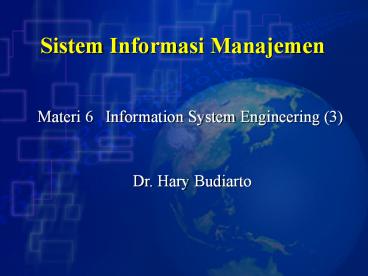System Analysis and Design Methods - PowerPoint PPT Presentation
Title:
System Analysis and Design Methods
Description:
Materi 6 Information System ... Base Design and Construction A Modern Data Architecture Database ... tools. A database management system ... – PowerPoint PPT presentation
Number of Views:246
Avg rating:3.0/5.0
Title: System Analysis and Design Methods
1
Sistem Informasi Manajemen
Materi 6 Information System Engineering (3)
Dr. Hary Budiarto
2
Process Model Design
3
Application Architecture
- An application architecture adalah suatu
teknologi spesifik untuk digunakan dalam
mengimplementasikan sistem informasi dalam bentuk
DATA, PROCESS, dan INTERFACE, serta bentuk
interaksinya. - It serves as an outline or blueprint for detailed
design and implementation.
4
Physical Data Flow Diagrams (DFDs)
- Physical data flow diagrams (DFDs) model the
technical and human decisions to be implemented
as part of an information system. - They communicate technical choices and other
design decisions to those who will actually
construct and implement the system.
5
Physical Data Flows
- A physical data flow represents any of the
following - The planned implementation of an input to, or
output from a physical process. - A database command or action such as create,
read, update, or delete. - The import of data from, or the export of data to
another information system across a network. - The flow of data between to modules or
subroutines (represented as physical processes)
in a program.
6
Sample Physical Data Flows
7
Sample Physical Data Flows
8
Physical Data Store Implementations
9
Data Base Design and Construction
10
A Modern Data Architecture
11
Database Architecture
- Database architecture refers to the database
technology including the database engine,
database utilities, CASE tools, and database
development tools. - A database management system (DBMS) is
specialized software that is used to create,
access, control, and manage the database. The
core of the DBMS is a database engine. - A data definition language (DDL) is that part of
the engine used to physically define tables,
fields, and structural relationships. - A data manipulation language (DML) is that part
of the engine used to create, read, update, and
delete records in the database, and navigate
between different files (tables) in the database.
12
Typical DBMS Architecture
13
User Interface Design and Construction
14
User Interface Options
Saat ini dalam melakukan User Interface Design
dengan cara manipulasi langsung dengan melalui
beberapa komponen yaitu
- Menu Selection (Pilihan Menu)
- Dialog Style (Ragam Dialog)
- Form Fill-in (Pengisian Fomulir)
15
Construction and Implementation
16
What Is System Construction and Implementation?
- Systems construction adalah tahapan pengembangan,
instalasi, dan testing untuk komponen sistem. - Systems implementation adalah tahapan operasional
sehari-hari untuk menjalankan sistem (meaning
day-to-day operation).
17
The Context of System Construction and
Implementation
18
Tasks for Completing The Construction Phase
- Build and Test Networks
- Build and Test Databases
- Install and Test New Software Package
- Write and Test New Programs
19
Tasks for Completing The Construction Phase
20
Levels of Testing
- Stub testing is the test performed on individual
events or modules of a program. In other words,
it is the testing of an isolated subset of a
program. - Unit or program testing is a test whereby all the
events and modules that have been coded and stub
tested for a program are tested as an integrated
unit. In other words, it is the testing of an
entire program. - Systems testing is a test that ensures that
application programs written and tested in
isolation work properly when they are integrated
into the total system
21
Tasks for Completing The Implementation Phase
- Conduct System Test
- Prepare Conversion Plan
- Install Databases
- Train Users
- Convert to New System
22
Tasks for Completing The Implementation Phase
23
Information System Operation and Support
24
Support versus Operation
An operational system is frequently called a
production system.
- Systems support is the on-going technical support
for users, as well as the maintenance required to
fix any errors, omissions, or new requirements
that may arise.
- Systems operation is the day-to-day,
week-to-week, month-to-month, and year-to-year
execution of an information systems business
processes and application programs.
25
The Context of Systems Operation and Support
26
Systems Development, Operation, and Support
27
Three Important Data Stores
- The repository is a data store(s) of accumulated
system knowledgesystem models, detailed
specifications, and any other documentation
accumulated during systems development. - The program library is a data store(s) of all
application programs. - The business data is all those data stores of the
actual business data created and maintained by
the production application programs.
28
Systems Support Activities
29
System Support Activities
- Program maintenance corrects bugs or errors
that slipped through the system development
process. - System recovery is the restoration of the system
and data after a system failure. - Technical support is any assistance provided to
users in response to inexperience or
unanticipated situations. - System enhancement is the improvement of the
system to handle new business problems, new
technical problems, or new technology
requirements.































